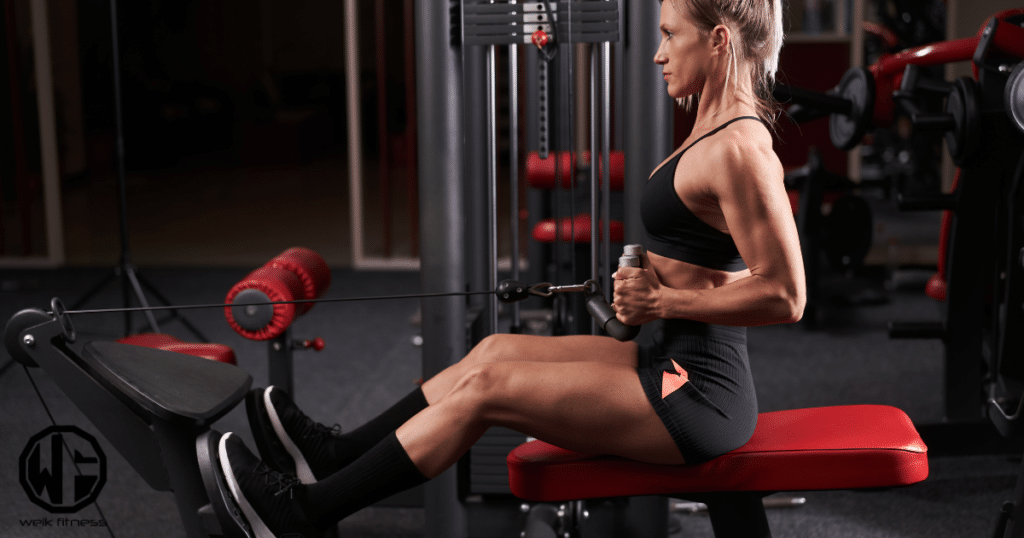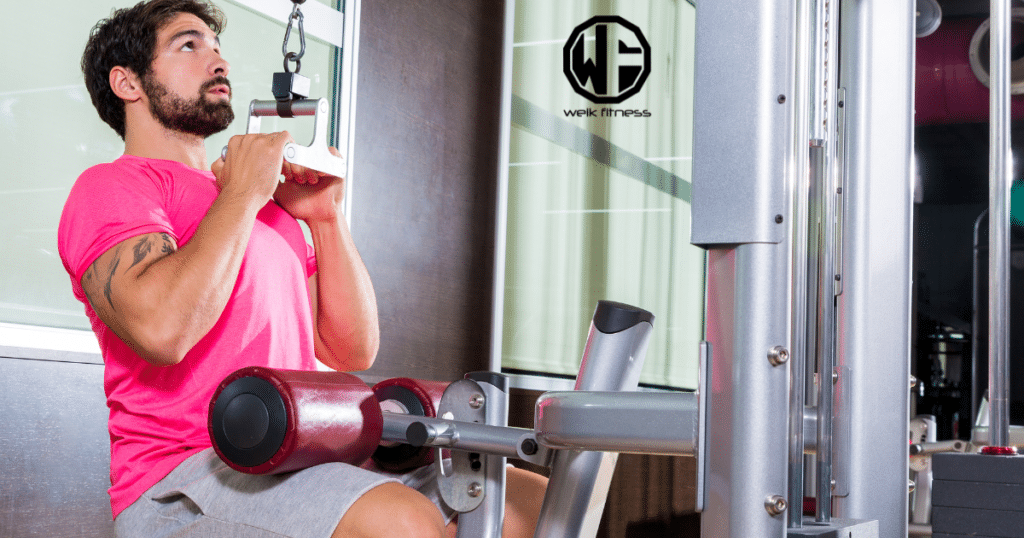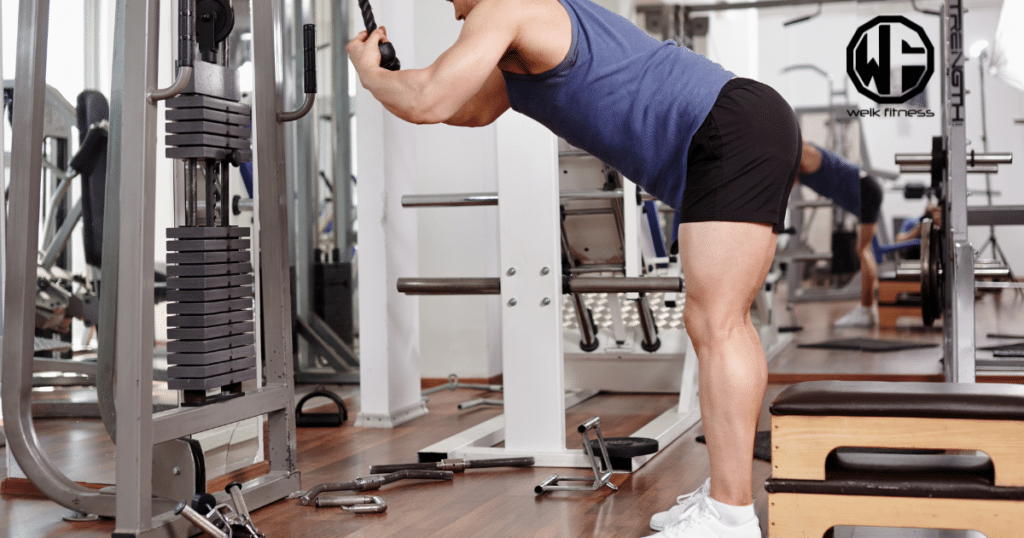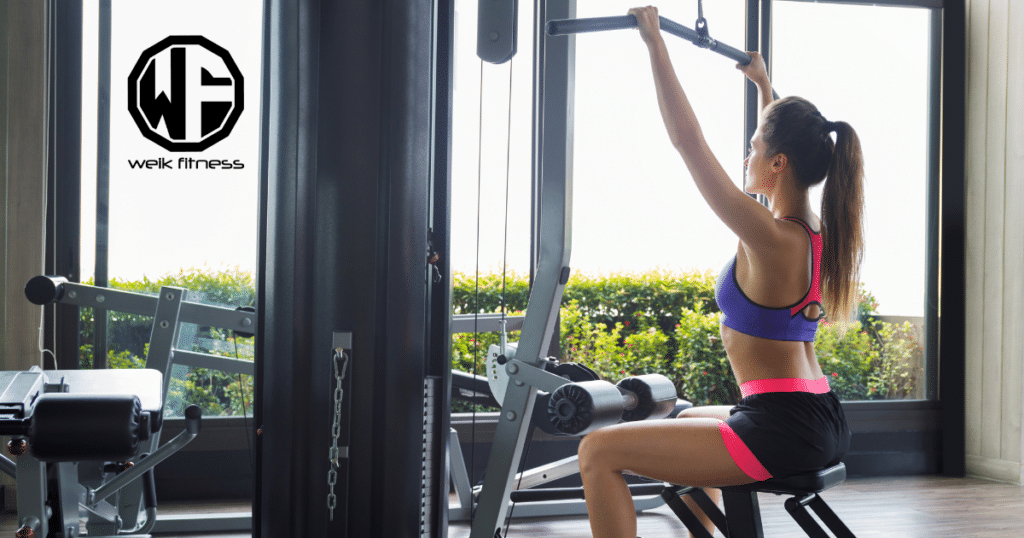The Best Back Cable Workouts & Exercises for Width
Are you struggling to widen your back? If so, you’re certainly not alone. Many folks hitting the gym regularly find that, despite their dedication and hard work, achieving that coveted V-shape seems just out of reach. But have you ever thought about back cable workouts?
Interestingly enough, it might all boil down to the equipment being used — or perhaps overlooked. One surprising fact is this: cable machines offer a unique kind of tension that can be incredibly effective for muscle growth, particularly in those stubborn upper body regions.
In my own journey toward building a broader back, I, too, felt confined by the limits of traditional weights and barbells and needed a change. That’s when I decided to take a deep dive into research and hands-on experimentation with various cable machine workouts.
The discoveries I made were nothing short of revelatory — an arsenal of exercises specifically designed to target and expand back muscles, from lat pull-downs to seated rows and much more.
Related Article: The Best Pull Day Workouts & Exercises for Functional Fitness
This article serves as a platform for me to share these transformative back cable workouts with you. You can expect comprehensive instructions on how to perform each exercise with precision for maximum growth of your back muscles.

Prepare yourself… this information could reshape your approach to training. Let’s jump into things!
Disclaimer: This article is for informational purposes only and is not meant to treat or diagnose any condition. It is recommended that you speak with your doctor before starting any exercise program, changing your daily nutrition, or adding any supplements to your regimen.
Table of Contents
- Key Takeaways
- Understanding the Benefits of Cable Back Exercises Using the Cable Machine
- The Best Cable Back Exercises for a Wider Upper Back
- 1. Mastering the Seated Cable Row
- 2. Perfecting the Single-Arm Cable Row
- 3. Lat Pulldowns for Width
- 4. The Importance of Cable Face Pulls for the Muscles of the Back
- 5. Building Strength with Cable Shrugs
- 6. Incline Cable Pullover Techniques
- 7. The Effectiveness of Straight Arm Cable Pulldowns
- 8. Enhancing Your Back with Reverse Cable Fly
- Tips for Enhanced Results from Cable Back Workouts
- Leverage the Best Back Cable Workouts and Best Back Exercises
- FAQs for the Best Back Cable Workouts
Key Takeaways
- Cable machines provide unique tension, which is crucial for muscle growth, especially in the upper body. They let you hit back muscles from all angles with a wide range of movements.
- Essential cable exercises like the seated cable row, single-arm cable row, and lat pulldowns are key to developing back width. These exercises target various muscles for overall strength and symmetry.
- Maintaining proper form and focusing on slow, controlled movements enhance muscle engagement and growth. Consistency in back cable workouts combined with proper nutrition supports muscle recovery and development.
- Incorporating different attachments and grips during your workout can challenge your muscles in new ways every session. This variety helps develop muscle evenly across the back.
- Exercises such as cable face pulls, shrugs, incline pullovers, straight arm pulldowns, and reverse flys offer comprehensive training targeting multiple back areas for balanced growth.

Understanding the Benefits of Cable Back Exercises Using the Cable Machine
Enhance your range of motion, isolate targeted muscles, and enjoy the versatility of cable back exercises. Benefit from improved muscle isolation and flexibility while engaging in effective upper and lower back workouts.
1. Enhanced Range of Motion to Build Bigger Back Muscles
Cable back exercises give your muscles a stretch and pull that free weights can’t match. This means you can move more freely and hit those back muscles from every angle. Whether it’s during a seated cable row or a lat pulldown, you’re getting the full benefit of stretching far and wide without being limited by gravity.
The cables make sure your movements are smooth and steady, allowing for a wider range of action.
Flexibility in training brings strength to performance, and back cable workouts can help get the job done.
Using a cable machine also adds variety to my workouts. I love how I can easily adjust the weight and switch exercises quickly — no need to fumble around with changing plates like on free weights.
It keeps my muscle groups guessing, which is crucial for building a strong back. From pulling the handle towards me in rows to reaching up high for pulldowns, every motion works different parts of my back, making my entire upper body stronger and more flexible.
2. Targeted Muscle Isolation Through Back Exercises with Cables
Targeted muscle isolation works wonders for your back. For instance, using cable machines lets you focus on specific muscles like the trapezius or rear deltoids. These might get less attention during traditional weightlifting.
With isolation exercises, I easily target these areas needing a bit more work.
I mix up my routine with various tools — think cable machines and dumbbells. This approach with back cable workouts helps me pinpoint precise muscles for development. It’s not just about lifting heavy; it’s about smart training to grow stronger in the right places.
3. Exercise Versatility During Back Training
Cable back workouts offer incredible flexibility. They let you hit your upper and lower traps, latissimus dorsi, erector spinae muscles, rotator cuffs, and teres major from angles free weights can’t match.
Related Article: HydroPrime Glycerol — Time for Massive Pumps and Hydration!
This means each exercise feels fresh and directly targets specific muscle groups for growth.
Switching up exercises is easy at the cable station. With a simple switch of attachments — like swapping a bar for a rope or handle — you can challenge your muscles in new ways every workout.
This versatility with back cable workouts keeps my training exciting and ensures all parts of my back develop evenly.
The Best Cable Back Exercises for a Wider Upper Back

Build a strong back with these fundamental cable exercises that focus on width.
1. Mastering the Seated Cable Row
The seated cable row targets the back muscles, specifically the latissimus dorsi or “lats,” building thickness and strength without excessive stress. It’s a high volume exercise; aim for 3 to 4 sets of 10 to 15 reps.
Set-Up:
- Securely place feet on the foot platform.
- Sit upright, keeping a straight back and holding the handle with an overhand grip.
Execution Tips:
- Pull the handle towards your torso and squeeze your shoulder blades together.
- Slowly return to the starting position, fully extending your arms.
Benefits of Seated Cable Row:
- It effectively trains your entire back.
- Can be tailored to target different muscle groups by adjusting grip width.
- Primarily works the back muscles while also engaging biceps as a secondary group.
Common Mistakes:
- Leaning too far back reduces muscle engagement and can strain the lower back.
- Rushing through reps sacrifices form and diminishes effectiveness.
Overall, mastering this exercise improves back strength and muscle definition, helping achieve a broader and more sculpted upper body.
2. Perfecting the Single-Arm Cable Row
Perfect the Single-Arm Cable Row for a wide and strong back by including it in your back cable workouts.
- The single-arm cable row allows for developing strength in different ranges of motion compared to traditional rows.
- This exercise targets and strengthens the back muscles, specifically targeting and hammering the trapezius, which contributes to achieving the desired width and thickness of the back.
- Incorporating the single-arm cable row is essential for building a robust, wide back.
Remember, maintaining proper form and consistency in your training is crucial to maximizing the benefits of this exercise.
3. Lat Pulldowns for Width
The lat pulldown is a popular back exercise for building wider lats. Different grip positions can target different muscles in the back during lat pulldowns. The straight-arm pulldown isolates the lats and removes biceps involvement. This contributes to shoulder and back strength.
- Wide Grip: Using a wider grip on the lat pulldown bar engages the outer portion of the lats, enhancing width.
- Close Grip: A closer grip emphasizes the lower portion of the lats, aiding in overall back development.
- Underhand Grip: The underhand grip focuses on upper-back engagement, contributing to a balanced width.
- Neutral Grip: Utilizing a neutral grip targets the middle portion of the lats, promoting width and density.
Remember that proper form and controlled movements are crucial for maximizing lat engagement during pulldowns and back cable workouts. It’s not merely about pulling weight; it’s about activating targeted muscle groups effectively.
4. The Importance of Cable Face Pulls for the Muscles of the Back
Cable face pulls are crucial for strengthening the shoulders and upper back muscles (if you’re a fan of Athlean X, you’ve probably heard about this exercise at least 47 million times).
They help prevent muscle imbalances and enhance rear delt strength.
Here’s why they deserve a place in your workout routine:
- Targeting the rear delts, essential for overall shoulder health and stability.
- Countering the effects of excessive chest training by balancing the upper body musculature.
- Activating the scapular retractors to improve posture and reduce the risk of shoulder injuries.
- Promoting balanced development across multiple shoulder and upper back muscle groups.
- Enhancing shoulder aesthetics, contributing to a broader, more powerful upper physique.
And now you know — Cable Face Pulls are an integral part of building a strong and visually impressive upper body!
5. Building Strength with Cable Shrugs
I build strength with Cable Shrugs by targeting my traps, working towards a bigger and stronger back.
- I stand in front of the cable machine with my feet shoulder-width apart and grasp the handles with an overhand grip.
- I engage my core and keep my shoulders back as I lift the handles straight up toward my ears, focusing on a controlled, upward movement.
- As I reach the top of the movement, I hold for a brief moment to really squeeze and activate my traps before slowly lowering the handles back down.
- Maintaining proper form is crucial to maximize the effectiveness of Cable Shrugs, ensuring that I don’t lean back or use momentum to lift the handles.
- To make each rep count, I perform 3 sets of 12-15 reps at a moderate weight, allowing for adequate muscle engagement and growth.
These maneuvers ensure that I effectively engage and strengthen my traps while avoiding unnecessary strain on other muscle groups in my back. Everyone should consider adding some shrugs to their back cable workouts.
6. Incline Cable Pullover Techniques
The Incline Cable Pullover is vital for targeting and developing the lats. It involves holding onto the straight bar attachment overhead with an overhand grip and extending the arms in front of you. This exercise helps in developing width and thickness of the back muscles.
- Start by adjusting the incline bench to a comfortable angle, usually between 45 to 60 degrees.
- Grab the straight bar attachment with an overhand grip, ensuring your hands are wider than shoulder-width apart.
- Sit on the bench and position yourself so that when you extend your arms, they are directly above your chest.
- Keep your feet flat on the floor, creating a stable base for this exercise.
- Begin by pulling the bar down towards your chest while keeping your arms relatively straight until you feel a stretch across your chest and lats.
- Slowly return to the starting position while maintaining control throughout the movement.
- Aim for 3-4 sets of 10-12 controlled repetitions, focusing on feeling the targeted muscles engage with each repetition.
Remember not to let gravity take over on the way up — maintain resistance throughout both phases of this exercise.
It’s important to note that utilizing proper form is crucial for maximizing benefits while minimizing injury risk during this cable pullover technique, as well as all exercises during back cable workouts.
Dive into these incline cable pullover techniques as they are designed to enhance back width effectively!
7. The Effectiveness of Straight Arm Cable Pulldowns
Straight arm pulldowns (which we very briefly touched on in the pulldown section above) effectively target the teres major, latissimus dorsi, triceps, and posterior deltoid muscles — essential for building upper body strength.
This versatile exercise can be performed using a cable and rope, allowing for varied resistance and range of motion.
It isolates specific muscle groups in the back, contributing to enhanced muscle domination and size.
Further variations, such as single-arm lat pulldown and kneeling single-arm lat pulldown offer effective means to engage these muscle groups during back cable workouts.
8. Enhancing Your Back with Reverse Cable Fly
The reverse cable fly exercise targets the rear deltoids, which helps in achieving well-balanced muscle development.
Here are some essential tips for performing reverse cable fly to enhance your back:
- Stand facing the cable machine with feet shoulder-width apart, holding the handles in each hand.
- Keeping a slight bend in your elbows, engage your core, and maintain a neutral spine throughout the movement.
- Pull the handles away from each other, leading with your elbows and squeezing your shoulder blades together at the end of the movement.
- Slowly return to the starting position, focusing on controlled movements and maintaining tension in your back muscles.
- Aim for high repetitions with moderate weight to maximize muscle engagement and growth.
- To fully engage your rear deltoids, focus on mind-muscle connection and avoid using momentum to complete the exercise.
With consistent practice and proper form, incorporating reverse cable fly into your back workout routine can lead to improved posture and strengthened rear deltoids for a more sculpted physique.
Tips for Enhanced Results from Cable Back Workouts

Below are some tips that can help improve your cable back workouts and fast-track your results.
1. Maintaining Proper Form with Back Cable Exercises
Maintaining proper form while doing cable back exercises is crucial for avoiding injuries and maximizing results. Controlled movements and engaging core strength are essential for stabilizing the spine and targeting key back muscles.
By mastering proper form, you can enhance muscle growth and strength, ensuring that each movement effectively works the muscles without straining other parts of your body. Moreover, maintaining proper form helps in isolating specific muscle groups, allowing for a more effective workout session.
Related Article: Cellflo6 — The Secret to Cellular Hydration & Better Performance
To ensure an effective cable back exercise routine, remember to focus on keeping your spine stable with controlled movements while engaging core strength. This will not only help prevent injury but also maximize muscle growth by targeting specific back muscles.
2. The Role of Slow and Controlled Movements with the Best Cable Exercises
Slow and controlled movements are crucial for building a strong mind-to-muscle connection, leading to better muscle contractions during back cable workouts. This also prolongs the time of tension on the muscles, which helps in developing strength and muscle mass.
Proper form during slow and controlled movements ensures that the correct muscles are targeted, maximizing back muscle growth.
Implementing these principles enhances workout efficiency. It’s vital to maintain proper form and focus on slow and steady execution of movements, allowing for optimal results from cable back exercises.
3. The Importance of Consistency with Effective Cable Workouts
Consistency is crucial for reaping the rewards of cable back workouts. Regular, consistent effort over time yields better long-term progress and results. When it comes to cable exercises, maintaining consistency ensures steady tension throughout each movement, leading to more effective muscle development.
It’s 100% necessary to commit to staying consistent in your back cable workouts.
4. Nutrition and Recovery for Muscle Growth
Proper nutrition is vital for muscle repair and growth after workouts. Balancing energy and timing nutrient intake are crucial for optimal recovery. Additionally, protein intake before and after exercise can sensitize muscles to enhance protein digestion, aiding in recovery.
Tracking weekly recovery helps maximize back muscle growth, so incorporating creatine can boost muscle and strength gain while improving endurance.
Ensuring the right nutrients at the correct time post-workout aids in optimal muscle recovery, while tracking weekly progress maximizes back muscle growth.
Personally, I leverage the following products as part of my post-workout recovery plan:

Leverage the Best Back Cable Workouts and Best Back Exercises
Incorporate cable back workouts for enhanced strength and width. Perfect your technique with exercises like seated cable row, single-arm cable row, and lat pulldowns. Emphasize consistency and proper form to maximize results.
Enhance your back training by embracing the versatility of cable machines.
FAQs for the Best Back Cable Workouts
Back cable workouts are awesome because they let you pull and lift using smooth, steady movements. This helps target muscles all over your back, including those hard-to-reach lower back muscles and upper back areas. Plus, you can adjust the weight easily to keep challenging yourself.
Absolutely! Exercises like cable rows, pulldowns, and deadlifts work wonders on your back’s width. They focus on pulling your shoulder blades together and working the sides of your back — that’s key for building a big, strong look.
Some of the best back cable workouts include cable pulldowns and rows because they’re perfect for hitting every muscle in your back. Don’t forget about single-arm variations or using a rope attachment to mix things up — these moves can help strengthen each side of your body evenly.
For real gains, aim to work out your back with cables at least twice a week. Remember to give yourself rest days in between so those muscles can recover and grow stronger.
While machines like the cable machine are fantastic tools, it’s good to vary your routine with free weights or bodyweight exercises, too. This way, you engage more muscle groups and improve overall strength and balance.
Yes! Keep an eye on form: pull those elbows down and bring shoulder blades together without hunching over; imagine squeezing something between them at the end of each move; start with lighter weights until you’re comfortable; finally, always ensure smooth movements rather than jerky pulls when doing back cable workouts.


*Disclosure: This article may contain affiliate links or ads, which means we earn a small commission at no extra cost to you if you make a purchase through these links. These commissions help support the operation and maintenance of our website, allowing us to continue producing free valuable content. Your support is genuinely appreciated, whether you choose to use our links or not. Thank you for being a part of our community and enjoying our content.
PLEASE CONSIDER SHARING THIS ON YOUR SOCIAL MEDIA TO HELP OTHERS LEARN MORE ABOUT THIS TOPIC. SIMPLY CLICK BELOW!

